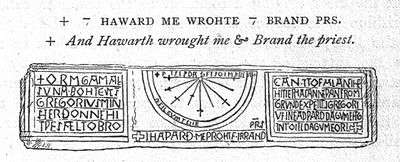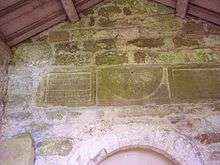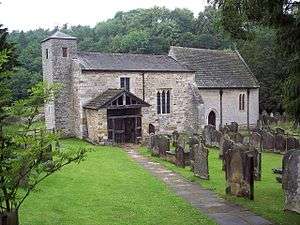Kirkdale sundial
Coordinates: 54°15′47.15″N 0°57′44.9″W / 54.2630972°N 0.962472°W


The Saxon sundial at St Gregory's Minster, Kirkdale, near Kirkbymoorside, North Yorkshire, England is an ancient canonical sundial which dates to the mid 11th century. The panel containing the actual sundial above the church doors is flanked by two panels, bearing a rare inscription in Old English, the language of the Anglo-Saxons. The sundial commemorates the rebuilding of the ruined church, about the year 1055, by Orm, son of Gamal, whose Scandinavian names suggest that he may have been a descendant of Vikings who overran and settled this region in the late 9th century.
Inscription
The inscription on the sundial reads as follows:
- + ORM GAMAL / SVNA BOHTE SCS / GREGORIVS MIN / STER ÐONNE HI / T ǷFS ÆL TOBRO // CAN 7 TOFALAN 7 HE / HIT LET MACAN NEǷAN FROM / GRVNDE ΧΡE 7 SCS GREGORI / VS IN EADǷARD DAGVM CNG / 7 [I]N TOSTI DAGVM EORL +
- Orm Gamal suna bohte Sanctus Gregorius Minster ðonne hit wæs æl tobrocan and tofalan and he hit let macan newan from grunde Christe and Sanctus Gregorius in Eadward dagum cyning and in Tosti dagum eorl.
(ǷFS may be an error for ǷES, though if the letters were originally painted, as seems quite possible,the E may have appeared intact. The Anglo-Saxon character represented in this transcription by '7' stands for the conjunction 'and'. Several characters in the Anglo-Saxon alphabet but no longer used in English appear in the inscriptions. Ð/ð (called 'eth')is equivalent to modern 'th', as also is þ (called 'thorn'). Ƿ (called 'wynn') is equivalent to modern 'w'; and Æ/æ (called 'ash') is here equivalent to modern 'a').
- "Orm son of Gamal bought St Gregory's Minster when it was all ruined and collapsed and he caused it to be made new from the ground for Christ and St. Gregory in the days of Edward the king and in the days of Tosti the eorl."[2]

The sundial itself is inscribed
- + ÞIS IS DÆGES SOLMERCA + / ÆT ILCVM TIDE
- þis is dæges solmerca, æt ilcum tide.
- "This is the day's sun-marker, at every tide."
And at the bottom of the central panel is the line
- +7 HAǷARÐ ME ǷROHTE 7 BRAND / PRS
- and Hawarð me wrohte and Brand presbyter(i) [or preostas] .
- "And Haward wrought me and Brand priest(s)."[2]
The reference is to Edward the Confessor and Earl Tostig, Edward's brother-in-law, who was the son of Earl Godwin of Wessex and the brother of Harold. Tostig held the Earldom of Northumbria from 1055 to 1065, fixing the date of the church's reconstruction to that decade. He is also known for the murder of Gamal, Orm's father. The language of the inscription is late Old English, with a failing case and gender system. The compound solmerca is otherwise unattested in English, and has been ascribed to Scandinavian influence (Old Norse solmerki 'sign of the zodiac').
Part of the sundial's historical significance is its testimony that, a century and a half after the Viking colonisation of the region, the settlers' descendants such as Orm Gamalson were now using English, not Danish or Norwegian, as the appropriate language for monumental inscriptions.[3]
Notes
- ↑ Wall, J. Charles (1912), Porches & Fonts.Pub. Wells, Gardner, Darton & Co., Ltd., London. P. 66.
- 1 2 Blair, John (2010). "The Kirkdale dedication inscription and it's Latin models: ROMANITAS in late Anglo-Saxon Yorkshire". In Hall, Alaric; Timofeeva, Olga; Fox, Bethany. Interfaces Between Language and Culture in Medieval England: A Festschrift for Matti Kilpio. Leiden, The Netherlands: Brill Academic Publishers. p. 140. ISBN 90-04-18011-7.
- ↑ [The Story of English episode 2 - The Mother Tongue — Part 4 / 7, PBS Documentary. See also discussion in S. A. J. Bradley, Orm Gamalson's Sundial (Kirkdale, 2002) and in M. Townend, Scandinavian Culture in Eleventh-Century Yorkshire (Kirkdale, 2009).
References
- David Scott and Mike Cowham Time Reckoning in the Medieval World – A study of Anglo – Saxon and early Norman Sundials. Great Britain, British Sundial Society 2010, pp. 46–46.
- Richard Fletcher, St. Gregory's Minster Kirkdale. Kirkdale: The Joint Church Council, 1990.
- James Lang, The Corpus of Anglo-Saxon Stone Sculpture: York and Eastern Yorkshire, Oxford, Oxford University Press, 1991.
- R. I. Page, How long did the Scandinavian language survive in England? The epigraphical evidence, In Clemoes and Hughes, eds. England before the Conquest: Studies in primary sources presented to Dorothy Whitelock. Cambridge, Cambridge University Press 1971, pp. 165–181.
- S. A. J. Bradley, Orm Gamalson's Sundial : The Lily's Blossom and the Roses' Fragrance (The Kirkdale Lecture 1997). Kirkdale: Trustees of the Friends of St Gregory's Minster, 2002. ISBN 0-9542605-0-3.
External links
- The Kirkdale Sundial Retrieved February 2012